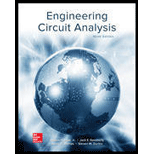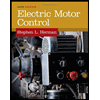
Engineering Circuit Analysis
9th Edition
ISBN: 9780073545516
Author: Hayt, William H. (william Hart), Jr, Kemmerly, Jack E. (jack Ellsworth), Durbin, Steven M.
Publisher: Mcgraw-hill Education,
expand_more
expand_more
format_list_bulleted
Concept explainers
Question
Chapter 12, Problem 14E
(a)
To determine
The current flowing through the neutral wire when
(b)
To determine
The new value of
Expert Solution & Answer
Want to see the full answer?
Check out a sample textbook solution
Students have asked these similar questions
I need help with this problem and an step by step explanation of the solution from the image described below. (Introduction to Signals and Systems)
I need help with this problem and an step by step explanation of the solution from the image described below. (Introduction to Signals and Systems)
10.49 Using source transformation, find i in the circuit of
Fig. 10.94.
5 Ω
www
3Ω
5 mH
8 sin(200t+30°) A
1 mF
Chapter 12 Solutions
Engineering Circuit Analysis
Ch. 12.1 - Let and . Find (a) Vad; (b) Vbc; (c) Vcd.Ch. 12.2 - Prob. 2PCh. 12.2 - Modify Fig. 12.9 by adding a 1.5 resistance to...Ch. 12.3 - A balanced three-phase three-wire system has a...Ch. 12.3 - A balanced three-phase three-wire system has a...Ch. 12.3 - Three balanced Y-connected loads are installed on...Ch. 12.4 - Each phase of a balanced three-phase -connected...Ch. 12.4 - Prob. 8PCh. 12.5 - Determine the wattmeter reading in Fig. 12.24,...Ch. 12.5 - Prob. 10P
Ch. 12 - Prob. 1ECh. 12 - Prob. 2ECh. 12 - Prob. 3ECh. 12 - Describe what is meant by a polyphase source,...Ch. 12 - Prob. 5ECh. 12 - Prob. 6ECh. 12 - Prob. 7ECh. 12 - Prob. 8ECh. 12 - Prob. 9ECh. 12 - Prob. 10ECh. 12 - The single-phase three-wire system of Fig. 12.31...Ch. 12 - Prob. 12ECh. 12 - Referring to the balanced load represented in Fig....Ch. 12 - Prob. 14ECh. 12 - Prob. 15ECh. 12 - Consider a simple positive phase sequence,...Ch. 12 - Assume the system shown in Fig. 12.34 is balanced,...Ch. 12 - Repeat Exercise 17 with Rw = 10 , and verify your...Ch. 12 - Prob. 19ECh. 12 - Prob. 20ECh. 12 - Prob. 21ECh. 12 - Prob. 22ECh. 12 - A three-phase system is constructed from a...Ch. 12 - Prob. 24ECh. 12 - Each load in the circuit of Fig. 12.34 is composed...Ch. 12 - Prob. 26ECh. 12 - Prob. 27ECh. 12 - A three-phase load is to be powered by a...Ch. 12 - For the two situations described in Exercise 28,...Ch. 12 - Prob. 30ECh. 12 - Prob. 31ECh. 12 - Prob. 32ECh. 12 - Repeat Exercise 32 if Rw = 1 . Verify your...Ch. 12 - Prob. 34ECh. 12 - Prob. 35ECh. 12 - Prob. 36ECh. 12 - A wattmeter is connected into the circuit of Fig....Ch. 12 - Find the reading of the wattmeter connected in the...Ch. 12 - (a) Find both wattmeter readings in Fig. 12.39 if...Ch. 12 - Circuit values for Fig. 12.40 are , , , , . Find...Ch. 12 - Prob. 41ECh. 12 - Prob. 42ECh. 12 - (a) Is the load represented in Fig. 12.41...Ch. 12 - Prob. 44E
Knowledge Booster
Learn more about
Need a deep-dive on the concept behind this application? Look no further. Learn more about this topic, electrical-engineering and related others by exploring similar questions and additional content below.Similar questions
- This exam is closed book, but you may use one 8.5x11" sheet of notes (both sides), handwritten by you Wote all answers kot on this test paper! Use the personal key number N (written above) on the parameters se fix to Show your work and explain your reasoning Partial credit will be given for partial solutions. When giving a numerical answer, specify units ill any apply. No credit will be given for solving problems from previous 1. For the AM signal with periodic message m() shown in Fig. 1 and modulation index = 0.03A a) find the carrier amplitude and carrier power; b) find the sideband power and compute the power efficiency & N = 15 4+N AA -(4+N) Fig. 1 r(s)→arrow_forward1. Tests of a 10 kVA, 230/2300 V single-phase transformer have yielded the following results: Vacuum test low voltage side: current = 0.45A Po = 70WLow side short circuit test: voltage = 11.6V Pcc = 224.3WDetermine: a. Parameters Rcc and Xcc of the equivalent circuit referring to the secondary.b. Transformer voltage regulation, if feeding a load of 4kVA, fp = 0.75 in delayc. Efficiency if the load is 7kVA, fp = 0.8 inductiveperform the calculations without using artificial intelligence, let it be by one of the assigned people pleasearrow_forward= 5. Design an Armstrong indirect FM modulator that generates an FM signal with a carrier frequency of (60+2M) MHz and Af 30 kHz. Use a narrowband FM generator with f. 200 kHz and Af= 12 Hz. The local oscillator must operate at a frequency in the range of 5-8 MHz, and frequency doublers, triplers, and quintuplers are available. Sketch the block diagram of your design, including values of all relevant parameters.arrow_forward
- 4. The system shown below must recover both messages from the frequency-division multiplexed signal whose spectrum is input to it. a) Determine the frequency of the local oscillator; b) determine the bandwidths B, and B2 of the two low-pass filters; and c) sketch the spectra of the output signals, numbering key points on the frequency & amplitude axes. 艹 f(kHz) Wipw -12V 4 cos(27fLal) LPF1 MS) LPF2 MSarrow_forward3. In a QAM receiver using synchronous detection, the local oscillator produces an accurate cosine wave 2cos(x), but the two receiver branches have mismatched lengths, causing a phase delay of -1/(3+N) radians in one branch, as shown. Compute the component of the quadrature channel message appearing in the in-phase output, and compute the component of the in-phase message appearing in the quadrature output. QAM signal Low-pass filter 151(1) (1) 200001 #12 2 sin[)] Ap= Low-pass -л(3+N) filter x2(1) my(1)arrow_forward2. For the message signal m(r) shown below: -2 a) sketch the FM waveform pru if -2xx 10', k-100Nx. Specify the maximum instantaneous frequency and the minimum instantaneous frequency values in kHz. b) sketch the PM waveform pru if -2x10' and k,-/4. As well as the maximum and minimum instantaneous frequency, specify the value of the phase shift at key points. 5x10*N- ww N=15arrow_forward
- Don't use ai to answer I will report you answerarrow_forwardPlease describe how to do each step in detail. thanksarrow_forward2. For the OPAMP below: g) Grounding the inputs, perform a DC analysis (assume beta is infinite and VBE=0.7V and neglect the early voltage),calculate the DC currents and voltages everywhere in the circuit (all the collector and emitter currents and voltages aswell as the output voltage). Note that Q4 is 4 times as big as Q9 and Q3h) If Q1 and Q2 have a beta of 100, calculate the input bias current to the opampi) What is the input common mode range of this opamp?j) Calculate the common mode gain if the early voltage of Q3 and Q6 is 50Vk) Calculate the differential gain vo/vid of this circuitI) Calculate the input and output impedance of the opamp assuming beta is 100m) Calculate the input referred offset (Vos) if R2=21Karrow_forward
- 1. For the difference amplifier below, R1=R3=10K, R2=R4=50k, assume opamp is ideala) Find the differential mode gain, Admb) Find the input impedance (differential, between wi and va)c) Find the common mode gain in the presence of resistor mismatch (If R3=R1+ deltaR1, R4=R2+ deltaR2, deltaR1=100, deltaR2=500)d) Find the common mode rejection ratio (CMRR)e) Find the input impedance and output impedancef) If the OPAMP has an input current of 100uA, find the output offset voltage, set Vi1 = Vi2=0Varrow_forwardFor the circuit shown, I-20 mA, R₁ =10000 2, R2 =2000 Q, R3 -2000 Q, R₁-6000 2, Vcc 5 V and the OPAMP is ideal with regions of operation are considered. The output current lo in mA is (choose the closet value): R₂ Is R₁ W VCC -VCC The relative tolerance for this problem is 1 %. -0.458 -0.833 6.667 -6.667 ○ 0.458 0.833 w R3 w RLarrow_forwardFor the circuit shown, let R₁-4, R2-50, R3-2, R4-77 and Vin-18. Find the current I₁ and voltage Vo as follows: Use op-amp building blocks to determine the voltage Vo1: V01 = Then use Vo1 to find the current 11: 1₁ = Find the voltage Vo: Vo= R1 www Vin R₂ ww V01 R3 The relative tolerance for this problem is 9 %. + R4 www +5°arrow_forward
arrow_back_ios
SEE MORE QUESTIONS
arrow_forward_ios
Recommended textbooks for you

How do Electric Transmission Lines Work?; Author: Practical Engineering;https://www.youtube.com/watch?v=qjY31x0m3d8;License: Standard Youtube License